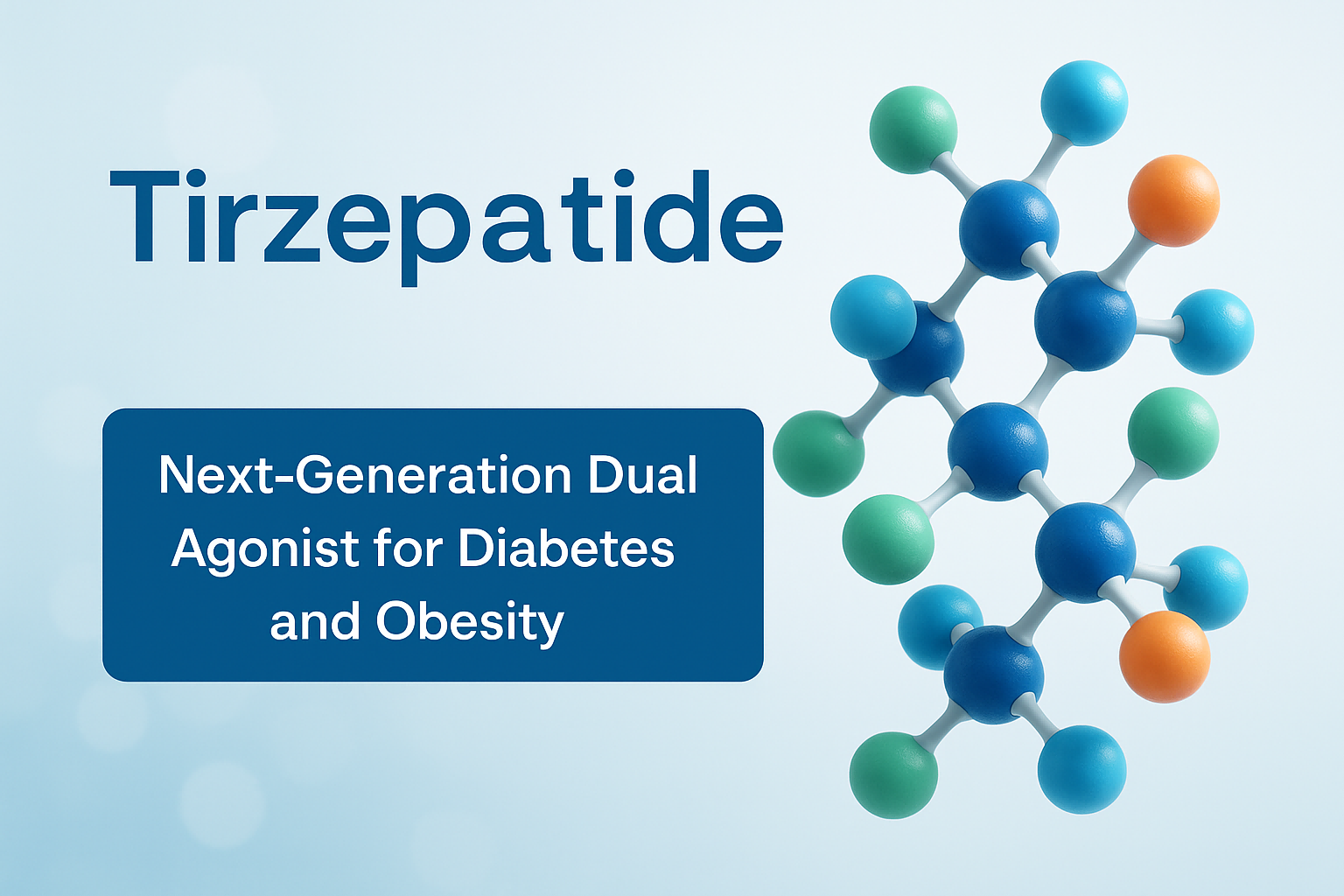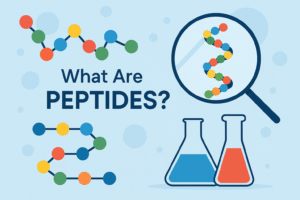Unlocking the potential of peptides—tiny biomolecules that play a big role in medicine, cosmetics, and life sciences.
1. 🧬 What Are Peptides?
Peptides are short chains of amino acids, typically consisting of 2 to 50 residues linked by peptide bonds. These bonds form through a dehydration reaction between amino and carboxyl groups of adjacent amino acids. Peptides are smaller than proteins but serve many of the same biological functions.
They are commonly categorized as:
- Dipeptides – 2 amino acids
- Tripeptides – 3 amino acids
- Oligopeptides – 2 to 20 amino acids
- Polypeptides – more than 20 amino acids
Once a peptide exceeds roughly 50 amino acids in length and begins folding into a stable three-dimensional structure, it’s usually classified as a protein.
Peptides serve as hormones, neurotransmitters, enzymes, signaling molecules, and even antimicrobial agents. Their versatility makes them fundamental to life and valuable tools in biotechnology, medicine, and cosmetics.
2. 🕰️ The History of Peptides
2.1 Early Discoveries
- 1882: The first protected peptide was synthesized by Theodor Curtius.
- 1901: Emil Fischer created the first free peptide and introduced the term “peptide” to describe the chemical link between amino acids.
- 1930s: The development of selective protective groups allowed chemists to synthesize longer and more complex peptides.
2.2 The Discovery of Insulin
The extraction of insulin in 1921 marked a turning point in both peptide chemistry and medicine. It was the first peptide-based drug to treat a major disease—diabetes. Later, Frederick Sanger sequenced insulin, proving that proteins (and peptides) have a precise and unique amino acid sequence.
2.3 Breakthroughs in Peptide Synthesis
- 1963: Bruce Merrifield introduced Solid-Phase Peptide Synthesis (SPPS), a revolutionary method that made the production of complex peptides more efficient, accurate, and scalable.
- This innovation eventually earned Merrifield the Nobel Prize and laid the foundation for modern peptide-based drug development.
2.4 Growth of Peptide Pharmaceuticals
With advancements in synthesis, purification, and modification technologies, peptide therapeutics grew rapidly. Today, dozens of peptide drugs are on the market treating conditions ranging from metabolic disorders to cancer and infectious diseases.
3. 💊 The Role of Peptides in Human Health
3.1 Metabolic Health
Peptides like insulin, glucagon, and GLP-1 analogs have become essential tools in managing blood sugar and treating diabetes and obesity. They regulate key metabolic pathways, offering high efficacy with fewer side effects.
3.2 Hormonal Regulation
Peptide hormones such as oxytocin and vasopressin play a central role in childbirth, social bonding, and water balance. Synthetic analogs of these peptides are now widely used in clinical settings.
3.3 Antimicrobial and Immune Support
Naturally occurring antimicrobial peptides (AMPs) serve as the body’s first defense against bacterial, viral, and fungal infections. These peptides are now being explored as alternatives to traditional antibiotics, especially in the fight against drug-resistant strains.
3.4 Wound Healing and Skin Regeneration
Peptides like GHK-Cu and Matrixyl stimulate collagen production, accelerate wound healing, and reduce inflammation. These are widely used in dermatology and anti-aging skincare products.
3.5 Cancer Therapy
Some synthetic peptides are used in targeted cancer treatments by binding specifically to tumor receptors, allowing for precise delivery of drugs or radiation with minimal damage to healthy cells.
4. 🔬 Innovations in Peptide Science
4.1 Designer Peptides
Scientists can now engineer peptides with specific sequences and structural features—cyclic peptides, stapled peptides, isotope-labeled peptides, and more—to enhance stability, bioavailability, and target specificity.
4.2 Diagnostic Applications
Peptides are used in diagnostic tests to detect antibodies, proteins, and pathogens. Their specificity and binding affinity make them ideal for use in ELISA kits and rapid diagnostics.
4.3 Peptides in Research
Custom peptides are key tools in understanding biological mechanisms. They are used to map protein interactions, validate antibody binding, and mimic functional domains of proteins.
4.4 Integration with Artificial Intelligence
AI-powered platforms are being developed to design novel peptides for therapeutic and industrial use. These tools can predict peptide activity, optimize sequences, and screen for toxicity, dramatically accelerating discovery.
5. 🌱 The Future of Peptides
5.1 New Drug Classes
Researchers are developing dual-function peptides, hybrid molecules, and peptide-drug conjugates that combine the best of small molecules and biologics. These have the potential to tackle previously untreatable conditions.
5.2 Vaccine Development
Peptides are being used to develop vaccines for cancer, viral infections, and autoimmune diseases. Their ability to stimulate specific immune responses makes them ideal for next-generation vaccine platforms.
5.3 Regenerative Medicine
Peptides that promote stem cell growth, tissue regeneration, and angiogenesis are being integrated into wound dressings, grafts, and implantable biomaterials.
5.4 Personalized Peptide Therapy
Peptide-based treatment strategies can now be personalized using genetic data. Peptides are also used in individualized cancer vaccines and autoantigen therapies for autoimmune diseases.
6. ⚖️ Benefits and Safety
Peptides offer several advantages:
- High specificity
- Low toxicity
- Minimal side effects
- Biodegradability
However, they are sensitive to temperature, enzymatic degradation, and must be stored and handled correctly. Only certified labs and manufacturers should be trusted for synthesis and delivery.
7. 🧪 Jennypeptide: Advancing Peptide Science
Jennypeptide specializes in the synthesis and modification of high-purity peptides for research, pharmaceuticals, and cosmetics. We provide:
- Custom synthesis of linear and modified peptides
- Over 400 types of chemical modifications
- Strict quality control with MS, HPLC, and other analytical reports
- Fast turnaround with delivery in as little as 3 days
- Global service to researchers, corporations, and institutions
Whether you need a fluorescently labeled peptide for imaging, a stapled peptide for drug discovery, or bulk peptides for clinical trials—Jennypeptide delivers.
8. 🖼️ Illustrative Figures (for website integration)
Figure 1: Peptide Bond Formation
(Illustration showing condensation reaction forming a peptide bond)
Figure 2: Peptide vs Protein
(Diagram comparing peptide chains vs full proteins by size and function)
Figure 3: Timeline of Peptide Discovery
(Visual roadmap of key peptide milestones: Fischer, insulin, SPPS, modern drugs)
Figure 4: Applications of Peptides in Human Health
(Infographic summarizing roles in metabolism, immunity, healing, and cancer therapy)
9. 📢 Conclusion
Peptides are small in size but immense in impact. From foundational biological roles to modern-day therapeutics, peptides have reshaped our understanding of life and medicine. With rapid innovation in synthesis, modification, and design, their potential is boundless.
At Jennypeptide, we’re proud to be part of this exciting journey—bridging science and application with every peptide we produce.
Explore our [Custom Peptide Synthesis] or [Product Catalog] to learn more.



